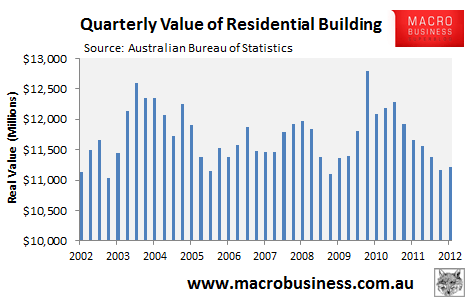
The release yesterday of quarterly construction data by the Australian Bureau of Statistics (ABS) seems to have piqued the interest of Australia’s banks, who were quick to call the bottom of Australia’s housing construction downturn and proclaim the beginning of an upswing. From Property Observer:
Westpac says the September quarter figures mark a turning point with lower interest rates begin to have an impact.
“This is the start of an upswing, although the strength of the cycle remains uncertain,” says Westpac.
CommSec economist Savanth Sebastian says the outlook for the residential sector “looks much brighter”.
“Lower interest rates, strong population growth, healthy employment, and pent up housing demand is starting to see the housing sector shake of the shackles and begin a much needed resurgence, says Sebastian.
However, ANZ was less excited about the improvement in residential building activity, which it said was consistent with the improvement that it has witnessed in residential building approvals – a lead indicator for construction work done.
“Nonetheless, activity within this sector remains subdued and while we are expecting residential construction activity to strengthen further going forward, a number of structural impediments are likely to constrain the prospective upturn.”
According to the ABS, the value of residential housing construction rose by a seasonally-adjusted o.6% in the September quarter, breaking five consecutive quarters of decline. However, despite this increase, the value of construction remained subdued, running -4.3% below the decade average in real (chain volume) terms (see below chart).

While the modest increase in residential construction is encouraging, one quarter does not make a trend, and it is probably too early, in my view, to proclaim that an upswing is in effect.
That said, I agree that that housing construction will pick-up from current depressed levels, but that any recovery will likely be fairly weak owing to Australia’s excessive vacant land prices, which have driven the price of new house and land packages beyond what many Australians can afford or are willing to pay. Until this situation is resolved, and land prices fall significantly, new home sales and construction levels are likely to disappoint.
Moreover, despite underlying demand supposedly running well above current rates of home construction, the worsening economic conditions as the mining boom unwinds is likely to lower overall demand for housing and weigh on the construction of new homes. More Australians are likely to opt for group accommodation in order to save on housing costs, which would adversely affect the rate of new home construction.
In order to drive land prices down, and lay the foundation for greater housing construction, significant reforms to restrictive state government planning policies are required, combined with improvements in infrastructure provision and financing. Ideally, these measures would also be supplemented with taxation reforms, such as the implementation of broad-based land taxes in place of less efficient (and less equitable) transaction taxes like stamp duties.
Twitter: Leith van Onselen. Leith is the Chief Economist of Macro Investor, Australia’s independent investment newsletter covering trades, stocks, property and yield. Click for a free 21 day trial.

